When an organization writes, it’s different from a person writing. Organizations are represented in the public imagination by a brand, which also includes visual elements alongside written components. These combine together to make up how your organization is perceived, and it’s incredibly important that all materials you create feel like they are part of your brand.
But when you’ve got multiple contributors all creating your content, how do you keep them on the same page and consistently creating content that represents your brand? The answer is a content style guide, which you can use to help contributors understand how to create content that matches how your organization operates, showcases its values, and communicates clearly with customers.
Your company’s style is what makes you instantly recognizable, even if your audience is not quite sure what it is. The style guide can encompass everything from how you use punctuation to the types of words you choose, and these can all be included in your content style guide.
📝 TL;DR
- Learn from these top content style guide examples to help you create your own document that informs and instructs your content creators.
- Be inspired by leading companies that have designed their own content style guides and published them publicly, enabling anyone to benefit from their expertise and authority.
What Is a Content Style Guide?
A content style guide is essentially a collection of rules for how you use writing and tone to convey your brand. It’s anything you deem important enough in your writing that represents your organization’s brand, organized into logical order so that anyone searching for your brand guidelines can find it in your content style guide.
It’s a list of instructions for your contributors who want to create content that adheres to your brand style. It means your contributors can’t go wrong when formatting content for use by your company, and that multiple contributors can create content that looks and feels similar, contributing to a coherent experience for the end users of your product who are familiar with your brand.
A content style guide is hosted on a knowledge base like Document360, instantly accessible online, and allows the AI-generated content or articles in Document360 to automatically follow the style guide. You can also easily change any of the content on your content style guide to keep it up-to-date for your teams.
Benefits of Using a Content Style Guide
Many organizations understand what a style guide is, but they’re reluctant to implement one. Here are the top reasons why you should consider creating a style guide for your team.
- Consistent brand voice across platforms – a content style guide ensures continuity in your brand voice across platforms, no matter how you choose to communicate with your customers. However you speak to your customers, you always sound like
- Faster onboarding of new team members – new team members can easily learn about your brand from the content style guide, which speeds up onboarding and quickly makes them a productive member of your team. New hires can become familiar with your existing brand and represent your company effectively from the very beginning.
- Improves accessibility and inclusivity in content – you can include rules about accessibility and inclusivity to ensure that all your content is easily readable across a broad spectrum of users. Accessibility becomes possible at a content level and embeddable across channels and platforms.
- Acts as a single source of truth, streamlining workflows – instead of requiring contributors to ask around for information, you have a single source of truth that offers all the information you need about branding. It’s the kind of information employees need to do their day-to-day jobs.
- Encourages plain English and avoids unnecessary jargon – you can tell your contributors to use plain English that can easily be understood by your users, avoiding complex and dense language that might put them off. Top brands can come across as friendly and humane with the right content style guide.
Content Style Guide Examples from Leading Brands
We’ve brought together the top brands that have created their own style guides and shared them for other organizations to learn from. These are household names and thus provide great inspiration for brands looking to create their own unique style guides.
Microsoft – Accessible and Straightforward
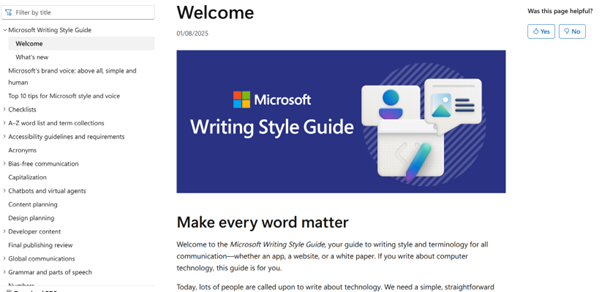
As you’d expect, Microsoft’s style guide is simple and straightforward. It’s all about teaching contributors to make the most of language, avoiding unnecessary words that detract from the meaning of the writing. As you can see, Microsoft’s list of categories is comprehensive, encouraging users to think about accessibility and bias.

Microsoft communicates its brand clearly with top tips on how to represent Microsoft through writing, using a few words, and writing like you speak. This helps to establish Microsoft as a relatable brand as well as an international powerhouse.
Google – Technical Precision and Developer-Focused
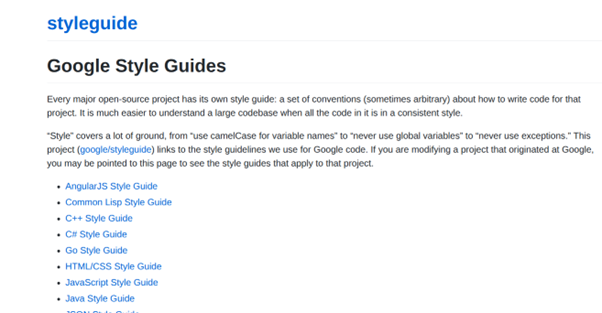
Google is a big player in the open source world, and thus includes a content style guide to help contributors understand how to write code in their Google open source project to ensure consistency and coherence.
Google lists all of its content by programming language, helping users to find the relevant content for their open source project. The simplicity of the presentation of Google’s content style guide makes it developer-focused and technically precise, with function more important than form.
Mailchimp – Friendly and Approachable Tone

As you might expect with Mailchimp, its content style guide encourages a friendly and approachable tone. In fact, the style guide itself is instantly recognizable as part of the Mailchimp brand, including the colors and the way the guide is written. The list of different writing formats is easily accessible on the left-hand menu, so contributors can navigate to the content that they need.

In fact, it’s not just about the practical elements but the principles behind your writing, helping contributors to channel the Mailchimp brand. It teaches contributors how to approach Mailchimp’s users, creating a consistent brand experience for those who are using Mailchimp’s products.
Build, share, and update your brand style guide effortlessly with Document360.
Book A Demo
Atlassian
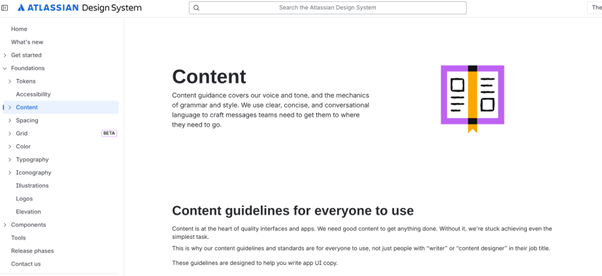
Atlassian has created its own style guide to help its team understand the company’s preferred voice and tone, especially when it comes to the use of conversational language that helps the Atlassian brand come across as more human.
They have a particular focus on inclusive language, which allows Atlassian to widen its audience. Other key considerations are language and grammar, and how to present dates and times to help global customers understand the meaning.

BBC – Clarity and Legal Considerations

BBC’s content style guide is strongly styled as the BBC brand, helping news contributors to write high-quality content for the BBC’s platform, right down to the most granular considerations. Since it is for news contributors for the BBC brand, it covers almost any element of writing an article for the website.
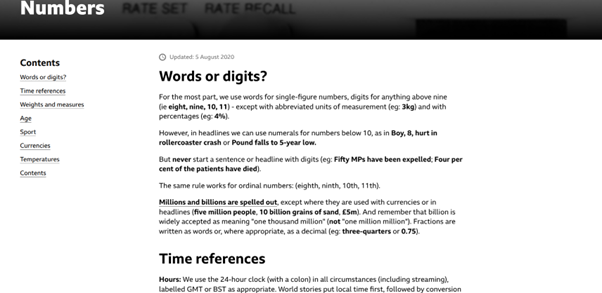
The BBC is extremely detailed in its instructions, letting users know how they would prefer numbers to be used in BBC content. The BBC style guide is so detailed that many other organizations refer to the BBC for their own house style guide, since it establishes a standard that can be followed by anyone.
Monzo – Plain English for Simpler Banking

Monzo, the well-known banking app, emphasizes customer experience when it comes to its content style guide. Avoiding jargon is a top priority for Monzo, which relies on engaging copy in its banking app to delight users, as writing is the primary way that Monzo communicates with customers.
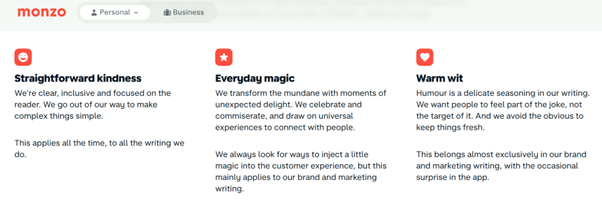
Monzo breaks down its principles just like some of the other brands we’ve mentioned here, showing writers clearly how to communicate with customers. These principles humanize Monzo and help contributors understand how to best represent the Monzo brand.
Intuit – A Full Content Design System
Intuit makes it extremely straightforward for contributors to understand its content style guide. They can navigate to any category they like when trying to immerse themselves in the Intuit brand.
Intuit has a whole section on how to talk to customers, bringing customers front and center to its brand. It makes sense that Intuit would be concerned about communicating with customers since that’s who the organization’s brand is primarily aimed at.
Key Elements Found in These Style Guides
- Tone and voice guidelines – every brand has a particular tone and voice that helps it communicate with customers. For example, Microsoft’s voice is “simple and human,” so every organization will use certain words to describe its tone and voice.
- Grammar and punctuation rules – particularly in content style guides like the BBC – detailed instructions regarding grammar and punctuation help contributors represent the brand right down to the full stop.
- Preferred and banned terminology – controlling the way contributors talk about the brand and related terminology is a huge part of content style guides, such as the way Shopify instructs its partners in how to talk about its brand. There is a right and wrong way to talk about Shopify.
- Accessibility standards: alt text, contrast, fonts – accessibility should be a given, but it isn’t, so brands often provide explicit instructions on how to improve accessibility standards at a content level. Consistency in itself helps improve accessibility.
- Formatting and design standards – don’t forget about visual concerns when it comes to the content style guide, for example, how to position the logo and what colors to use. Design standards determine how your brand is portrayed in the public sphere.
- Examples and templates for guidance – many style guides include examples to help contributors understand how to apply the style guide in a practical context, instead of just relying on abstract concepts. Showing contributors how to do it helps bring your brand to life.
How to Create Your Own Content Style Guide
- Start with brand voice and tone – first, teach your contributors how your brand sounds with a simple combination of words. Hit the nail on the head when it comes to defining the voice and tone, so every contributor can sound in keeping with the brand when they write their content.
- Define formatting and terminology rules – the devil is in the details for your content style guide, so make sure your formatting and terminology rules are explicit. Your users may not notice the difference, but they are crucial in defining your brand.
- Involve multiple teams for input – the content style guide isn’t just one person’s job. Collaboration between teams helps create the best style guide possible that can represent the priorities across the organization.
- Keep it digital, searchable, and simple – as we mentioned about hosting your style guide on Document360, you must keep it digital and searchable to help contributors find your standards no matter where they are.
- Cover visuals and microcopy too – you can include anything to do with your brand in the content style guide, so cover visuals and microcopy for a comprehensive document that contains all aspects of your brand.
- Update regularly with new standards – the Document360 knowledge base allows you to frequently update your content style guide with the latest tips and tricks on how to represent your brand.
Conclusion
A content style guide is your handbook for contributors who need to represent your brand in their content. It allows an ever-growing team of content producers to collaborate on your brand content while maintaining consistency and coherence, so customers instantly recognize your brand.
Your style guide can be part of your brand itself, with easy visual and styling elements available on hosting software such as Document360. The wording of your style guide helps make it obvious how you want contributors to sound, following in the footsteps of top brands like MailChimp, Microsoft, and the BBC, completely elevating your professionalism.
Your content will be vastly improved with a content style guide, with more consistency and better accessibility. You’ll be able to create content faster and end up with better quality through less effort, because you’ve taken the time to produce a content style guide.





 –
– 

